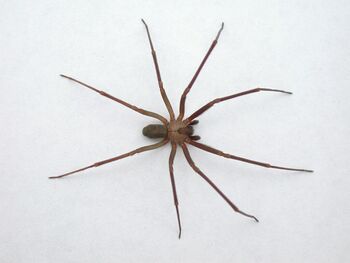
The brown recluse spider or violin spider, Loxosceles reclusa, Sicariidae (formerly placed in a family "Loxoscelidae") is a spider with a venomous bite.
Brown recluse spiders are usually between 6–20 mm (1⁄4 in and 3⁄4 in), but may grow larger. While typically light to medium brown, they range in color from cream-colored to dark brown or blackish gray. The cephalothorax and abdomen may not necessarily be the same color. These spiders usually have markings on the dorsal side of their cephalothorax, with a black line coming from it that looks like a violin with the neck of the violin pointing to the rear of the spider, resulting in the nicknames fiddleback spider, brown fiddler, or violin spider.
Description[]
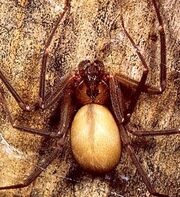
Since the violin pattern is not diagnostic, and other spiders can have similar markings (such as cellar spiders and pirate spiders), for more assurance in identification it is imperative to examine the eyes. Most spiders have eight eyes; recluse spiders have six eyes arranged in pairs (dyads) with one median pair and two lateral pairs. Only a few other spiders have three pairs of eyes arranged in this way (e.g., scytodids). Recluses have no obvious coloration patterns on the abdomen or legs, and the legs lack spines. The abdomen is covered with fine short hairs that, when viewed without magnification, give it the appearance of soft fur. The leg joints may appear to be a slightly lighter color.
Life-cycle[]
Adult brown recluse spiders often live about one to two years. Each female produces several egg sacs over a period of two to three months, from May to July, with approximately fifty eggs in each sac. The eggs hatch in about one month. The spiderlings take about one year to grow to adulthood. The brown recluse spider is resilient, and can tolerate up to six months of extreme drought and scarcity or absence of food, most notably observed on one occasion to survive in controlled captivity for over five seasons without food.
Behavior[]
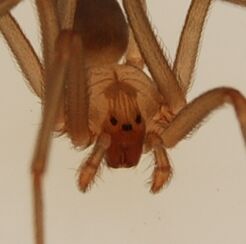
A brown recluse's stance on a flat surface is usually with all legs radially extended. When alarmed it may lower its body, withdraw the forward two legs straight rearward into a defensive position, withdraw the rearmost pair of legs into a position for lunging forward, and stand motionless with pedipalps raised. The pedipalps in mature specimens are dark, quite prominent, and are normally held horizontally forward. When threatened it usually flees, seemingly to avoid a conflict, and if detained may further avoid contact with quick horizontal rotating movements. The spider does not usually jump unless touched brusquely, and even then its avoidance movement is more of a horizontal lunge rather than a vaulting of itself entirely off the surface. When running the brown recluse does not appear to leave a silk line behind, which at any rate might make it more easily tracked when it is being pursued. Movement at virtually any speed is an evenly paced gait with legs extended. When missing a leg or two it appears to favor this same gait, although (presumably when a leg has been injured) it may move and stand at rest with one leg slightly withdrawn. During travel it stops naturally and periodically when renewing its internal hydraulic blood pressure that, like most spiders, it requires to renew strength in the legs.
Habitat[]
Brown recluse spiders build irregular webs that frequently include a shelter consisting of disorderly thread. They frequently build their webs in woodpiles and sheds, closets, garages, plenum spaces, cellars, and other places that are dry and generally undisturbed. When dwelling in human residences they seem to favor cardboard, possibly because it mimics the rotting tree bark which they inhabit naturally. They have also been encountered in shoes, inside dressers, in bed sheets of infrequently used beds, in clothes stacked or piled or left lying on the floor, inside work gloves, behind baseboards and pictures, in toilets, and near sources of warmth when ambient temperatures are lower than usual. Human-recluse contact often occurs when such isolated spaces are disturbed and the spider feels threatened. Unlike most web weavers, they leave these lairs at night to hunt. Males move around more when hunting than do females, which tend to remain nearer to their webs.
Distribution[]
The brown recluse spider is native to the United States from the southern Midwest south to the Gulf of Mexico. The native range lies roughly south of a line from southeastern Nebraska through southern Iowa, Illinois, and Indiana to southwestern Ohio. In the southern states, it is native from central Texas to western Georgia and north to Kentucky.
Despite rumors to the contrary, the brown recluse spider has not established itself in California anywhere outside its native range. Over the last century, occasional spiders have been intercepted in various states where they have no known established populations; these spiders may be transported fairly easily, though the lack of established populations well outside the natural range also indicates that such movement has not led to colonization of new areas, after decades of opportunities. Note that the occurrence of brown recluses in a single building (such as a warehouse) outside of the native range is not considered a successful colonization; such single-building populations can occur (e.g., several such cases in Florida), but do not spread, and can be easily eradicated.
There are other species of the genus Loxosceles native to the southwestern part of the United States, including California, that may resemble the brown recluse, but these species have never been documented as medically significant. The number of "false positive" reports based on misidentifications is considerable; in a nationwide study where people submitted spiders that they thought were brown recluses, of 581 from California only 1 was a brown recluse—submitted by a family that moved from Missouri and brought it with them (compared to specimens submitted from Missouri, Kansas, and Oklahoma, where between 75% and 90% were recluses).[1]From this study, the most common spider submitted from California as a brown recluse was in the genus Titiotus, whose bite is deemed harmless. A similar study documented that various arachnids were routinely misidentified by physicians, pest control operators, and other non-expert authorities, who told their patients or clients that the spider they had was a brown recluse when in fact it was not. Despite the absence of brown recluses from the Western U.S., physicians in the region commonly diagnose "brown recluse bites", leading to the popular misperception that the spiders occur there.
Bite[]
As suggested by its specific epithet
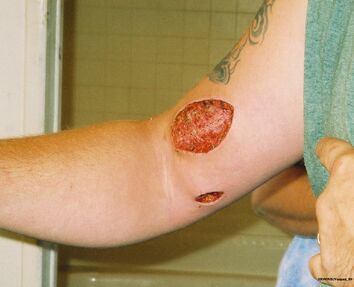
reclusa (recluse), the brown recluse spider is rarely aggressive, and bites from the species are uncommon. In 2001, more than 2,000 brown recluse spiders were removed from a heavily infested home in Kansas, yet the four residents who had lived there for years were never harmed by the spiders, despite many encounters with them. The spider usually bites only when pressed against the skin, such as when tangled within clothes, towels, bedding, inside work gloves, etc. Many human victims report having been bitten after putting on clothes that had not been worn recently, or had been left for many days undisturbed on the floor. However, the fangs of the brown recluse are so tiny they are unable to penetrate most fabric.
The bite frequently is not felt initially and may not be immediately painful, but it can be serious. The brown recluse bears a potentially deadly hemotoxic venom. Most bites are minor with no necrosis. However, a small number of brown recluse bites do produce severe dermonecrotic lesions (i.e. necrosis); an even smaller number produce severe cutaneous (skin) or viscerocutaneous (systemic) symptoms. In one study of clinically diagnosed brown recluse bites, skin necrosis occurred 37% of the time, while systemic illness occurred 14% of the time. In these cases, the bites produced a range of symptoms common to many members of the Loxosceles genus known as loxoscelism, which may be cutaneous and viscerocutaneous. In very rare cases, bites can even cause hemolysis—the bursting of red blood cells.
Forty-nine percent of brown recluse bites do not result in necrosis or systemic effects. When both types of loxoscelism do result, systemic effects may occur before necrosis, as the venom spreads throughout the body in minutes. Children, the elderly, and the debilitatingly ill may be more susceptible to systemic loxoscelism. The systemic symptoms most commonly experienced include nausea, vomiting, fever, rashes, and muscle and joint pain. Rarely, such bites can result in hemolysis, thrombocytopenia, disseminated intravascular coagulation, organ damage, and even death. Most fatalities are in children under the age of seven or those with a weak immune system.
While the majority of brown recluse spider bites do not result in any symptoms, cutaneous symptoms occur more frequently than systemic symptoms. In such instances, the bite forms a necrotizing ulcer that destroys soft tissue and may take months to heal, leaving deep scars. These bites usually become painful and itchy within 2 to 8 hours. Pain and other local effects worsen 12 to 36 hours after the bite, and the necrosis develops over the next few days. Over time, the wound may grow to as large as 25 cm (10 inches). The damaged tissue becomes gangrenous and eventually sloughs away.
Bite treatment[]
First aid involves the application of an ice pack to control inflammation and prompt medical care. If it can be easily captured, the spider should be brought with the patient in a clear, tightly closed container so it may be identified.
Routine treatment should include elevation and immobilization of the affected limb, application of ice, local wound care, and tetanus prophylaxis. Many other therapies have been used with varying degrees of success, including hyperbaric oxygen, dapsone, antihistamines (e.g., cyproheptadine), antibiotics, dextran, glucocorticoids, vasodilators, heparin, nitroglycerin, electric shock, curettage, surgical excision, and antivenom.[30][31] None of these treatments have been subjected to randomized controlled trials to conclusively show benefit. In almost all cases, bites are self-limited and typically heal without any medical intervention.
Cases of brown recluse venom traveling along a limb through a vein or artery are rare, but the resulting tissue mortification can affect an area as large as several inches and in extreme cases require excising of the wound.
Specific treatments[]
In presumed cases of recluse bites, dapsone is often used effectively for the treatment of necrosis, but controlled clinical trials do not demonstrate similar effectiveness. However, dapsone may be effective in treating many "spider bites" because many such cases are actually misdiagnosed microbial infections. There have been conflicting reports about its efficacy in treating brown recluse bites, and some have suggested it should no longer be used routinely, if at all.
Wound infection is rare. Antibiotics are not recommended unless there is a credible diagnosis of infection.
Studies have shown that surgical intervention is ineffective and may worsen outcome. Excision may delay wound healing, cause abscesses, and lead to scarring.
Anecdotal evidence suggests that the application of nitroglycerin patches can be beneficial. Brown recluse venom is a vasoconstrictor, and nitroglycerin causes vasodilation, allowing the venom to be diluted into the bloodstream and fresh blood to flow to the wound, theoretically preventing necrosis (as vasoconstriction may contribute to necrosis). However, one scientific animal study found no benefit in preventing necrosis, with the study's results showing it increased inflammation and caused symptoms of systemic envenoming. The authors concluded the results of the study did not support the use of topical nitroglycerin in brown recluse envenoming.
Antivenom, available in South America for the venom of other species of recluse spiders, appears to be the most promising therapy. They are most effective if given early. However, the bites, often being painless, usually do not present symptoms until 24 or more hours after the event, possibly limiting the effect of this intervention.
Survival[]
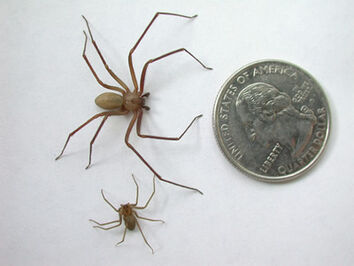
Due to the emphasized fear of these spiders ever since the increase of public awareness in recent years, extermination of domestic brown recluses is performed frequently in the lower Midwest. Brown recluse spiders possess a variety of adaptations, including the abilities to maintain homeostasis for several seasons with no food or water and to survive after losing limbs. Additionally, the spiders survive significantly longer in a relatively cool, thermally stable environment.
The increased abilities of the spiders to survive during times of starvation, thirst, and regulated room temperatures makes extermination of this species particularly challenging. Many chemicals which have proven effective have now been made illegal or restricted in the U.S., making the use of chemicals to eradicate the spiders impractical. Chemicals that do not kill the spider may cause disruption to its nervous system or other systems, inducing undesirable aggressive behavior.
